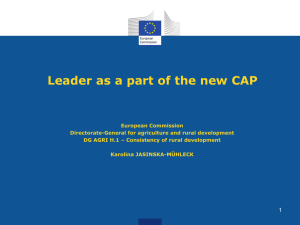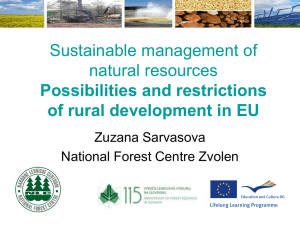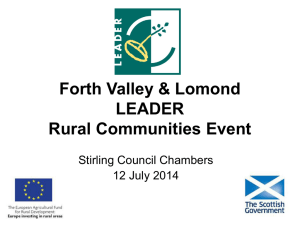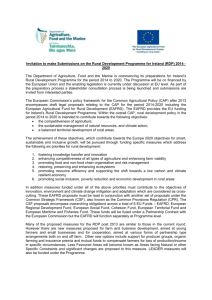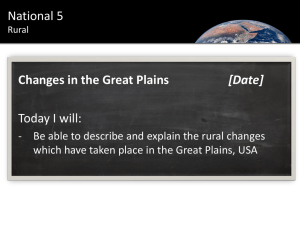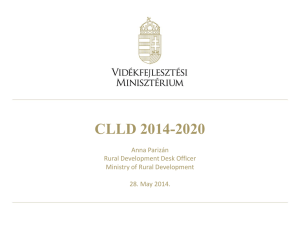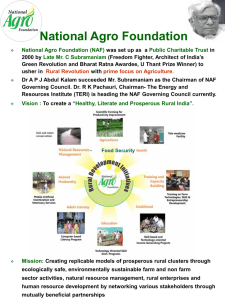CAP-PPT-EN
advertisement
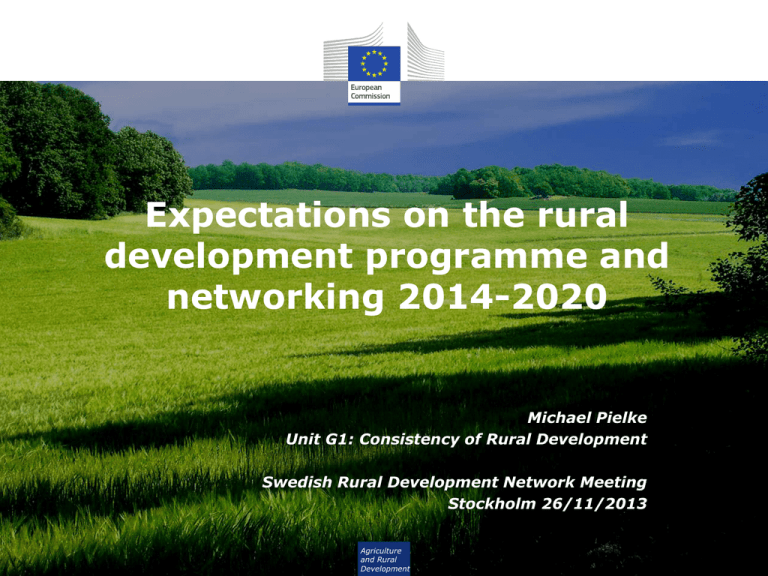
Expectations on the rural development programme and networking 2014-2020 Michael Pielke Unit G1: Consistency of Rural Development Swedish Rural Development Network Meeting Stockholm 26/11/2013 Agriculture and Rural Development Calendar for the new Rural Development Policy November 2010 October 2011 April 2013 26 June 2013 Communication on "The CAP towards 2020" Legal proposals for the CAP reform and the Common Provisions Regulation for the ESI-Funds Start of the trilogues (European Comm. – Council – Europ. Parl.) Political agreement between the Institutions Adoption in the Plenary of the European Parl. November 2013 (CAP texts + CPR) - Rural Development (Capoulas Santos): 576 votes in favour, 101 against and 11 abstentions 2 Calendar for the new Rural Development Policy (2) December 2013 Adoption of the legal basic acts Dec 2013 / Jan 2014 Publication of the legal basic acts May/June 2014 Publication of the delegated acts June 2014 Publication of the implementing acts 3 Main elements of the reform More effective rural development policy Better co-ordination with other EU funds 4 Reinforced strategic programming Changes to the measure menu Better co-ordination with other EU funds 5 Better co-ordination with other EU funds European Level Common Provisions Regulation for ESI Funds • Covering the EAFRD, ERDF, ESF, CF, EMFF • Reflecting EU 2020 Strategy through 11 common thematic objectives to be addressed by key actions for each of the funds National Level National or Regional Level 6 Partnership Agreement National document outlining the intended use of the funds in the pursuit of EU 2020 objectives Rural Development Programme(s) • (+ other funds' "operational programmes") Reinforced strategic programming 7 Reinforced strategic programming 6 Union priorities for rural development 1. Knowledge transfer / innovation in agriculture, forestry, rural areas 2. Viability of all types of farming in all regions; innovative farm technologies; Sustainable management of forests 3. Food chain organisation, animal welfare, risk management in agriculture 4. Ecosystems related to agriculture and forestry 5. Resource efficiency, low-carbon / climate-resilient economy in agriculture, food and forestry sectors 6. Social inclusion, poverty reduction and economic development in rural areas 8 8 Reinforced strategic programming Grouping of measures and indicators per focus areas: an example Priority 5: Promoting resource efficiency and supporting the shift towards a low-carbon and climate-resilient economy in agriculture, food and forestry sectors Focus areas Grouping of relevant measures Efficiency in water use Efficiency in energy use Supply and use of renewable energy Reducing GHG and ammonia emissions • • • • • • • Investments in physical assets Farm and business development Village renewal and basic infrastructure Knowledge transfer Advisory services Investments in forest area development Co-operation (new technologies) [….] Carbon conservation and sequestration Indicators Targets Planned expenditure (result) Planned outputs 9 Measure details (example) - Indicative list of relevant operations to be supported - Eligibility rules - Aid intensities - Beneficiaries - Indicative budget - Other conditions, etc. Reinforced strategic programming Required minimum budgetary allocations • A minimum amount of the total EAFRD contribution to the RDP must be reserved as follows: At least 30% for: environment- and climate-related investments (Article 18) forestry measures (Articles 22-27 and Article 35) agri-environment-climate (Article 29) organic farming (Article 30) Natura 2000 payments (Article 31 with the exception of WFD related payments) Payments in areas facing natural constraints (ANCs - Articles 3233) At least 5% for Leader 10 Other considerations "Show me the money" • Total EAFRD amount 2014-2020: € 84,936 M • Basic maximum co-financing rate = 53 % • Higher maximum rates for various regions Less developed regions, outermost regions, smaller Aegean Islands, transition regions • Higher maximum rates for certain measures Knowledge transfer (art. 15), producer groups (art. 28), cooperation (art. 36), LEADER • Higher maximum rate for operations contributing to environment- and climate-related objectives Under arts. 18, 23, 24, 29, 30, 31 (3 / 4), 32, 35 • Higher rates in various other circumstances E.g. funds transferred from Pillar I (100 %) 11 Changes to the measure menu 12 Changes to the measure menu Measures: the overall approach • Some measures from 2007-13 rolled together for better visibility • Many adjustments to scope, eligibility conditions, aid amounts etc. of existing measures, e.g.: Shorter contracts for agri-environment-climate measure after initial 5year phase • New measures to cover emerging needs, e.g.: Co-operation (art. 36) – various forms of joint activity to deliver economic, environmental & social benefits; technological development (including for European Innovation Partnership) Risk management (art. 37) – insurance, mutual funds, income stabilisation tool 13 RD measures Farm and business development (art. 20) • 3 types of operations: Setting-up aid for: Young Farmers – Conditional on the submission of a business plan, which has to start being implemented within 9 months from the date of the decision granting the aid. Non-agricultural activities in rural areas: extended from micro- to small businesses) Development of small farms: extended to all "small" farms in EU - defined by Member States Investments in non-agricultural activities Support for farm restructuring Annual or one-off payments for farmers eligible for the small farmers scheme under Pillar 1 who permanently transfer their holding to another farmer • Aid rates: 70.000 per young farmer 70.000 per beneficiary who diversifies 15.000 per small farm for development operations 14 Changes to the measure menu Measure example: Co-operation (art. 36) Sharing facilities, resources Tourism services Short supply chains, local markets Experimental development / refinement Pilot projects Co-operation Environment / climate change Provision of biomass Encouraging joint solutions Non-LEADER local development strategies 15 Forest management plans Social farming Changes to the measure menu LEADER in rural development programmes • constitutes a specific element of CLLD to be included obligatory in a RDP: preparatory support; implementation of operations under the CLLD strategy; preparation and implementation of co-operation activities of the LAG; running costs; animation costs. • LEADER should not be limited to standard RD measures. • Streamlined LEADER cooperation • Compulsory with a minimum of 5% of the EAFRD funding per programme and possibility of higher co-financing rates 16 RD measures Advantages of the common CLLD approach for LEADER • Common local development approach in the ESI-Funds facilitates integrated territorial development EAFRD Rural area Harmonised rules for design and implementation of CLLD "Multi-funded" LEADER strategies enable various EU policies to contribute to local development according to their policy objectives ERDF ESF - Strategic approach in PA, reflected in the programmes, based on LAG/FLAG experience Added value for rural areas: broader strategies and Local Action Group partnerships, improvement of rural-urban relations, synergies with Fisheries Local Action Groups - Which types of areas should be supported and with which of the Funds? What is the available funding? - LAGs decide to which extent they want to make use of the possibilities offered 17 RD measures Advantages of the common CLLD approach for LEADER • Common methodology strengthens the LEADER approach (Art. 28-31 CPR) Greater focus on capacity building and animation Stronger local strategies Better LAG governance: strengthening the participation of the private sector in the partnerships - Contribution to programme objectives - Coherence and consistency with "topdown" or other strategies - Local needs identified through SWOT analysis - Bottom-up process 18 Changes to the measure menu EIP on Agricultural Productivity and Sustainability • A new facility for building bridges between research and practice, whilst encouraging innovation • Acts through operational groups carrying out innovative projects Model story of an operational group: a farmer has an innovative idea but does not have means to develop it. He/she joins forces with e.g. a scientist, a farm advisor and a technology supplier and they set up an operational group. The idea is developed and shared via the networks. EAFRD co-finances project-specific costs and costs of co-operation. • Supported by a national and EU network National network can be part of the Rural Network • Key RD measures for implementing the EIP: Co-operation Investments (various measures) Knowledge transfer Advisory services 19 Networking 20 Networking • National Rural Networks • European network for rural development • • • • • - aims to: increase the involvement of all stakeholders in the implementation improve the quality of rural development programmes informing the broader public on the benefits of RD policy support the evaluation of rural development programmes EIP network – aims to: • facilitate the exchange of expertise and good practices; • establish a dialogue between farmers and the research community and facilitate the inclusion of all stakeholders in the knowledge exchange process 21 Objectives and tasks of the NRNs Objectives/ Tasks Involve Improve the Inform the Foster stakequality of RDP broader public innovation holders implementation and potential beneficiaries Thematic and analytical exchanges between stakeholders, sharing and dissemination of findings Share and disseminate monitoring and evaluation findings Networking activities for advisors and innovation support services Collection of examples of projects covering all RDP priorities Training and networking activities for LAGS Publicity and information concerning the RDP, information and communication activities aimed at a broader public Participate in and contribute to the ENRD activities 22 Cooperation with ENRD and EIP: Participation at meetings and exchanges at EU level Input into planning at EU level Providing examples of projects and good practices Providing information for network statistics Contribution to thematic work Contribution to EIP Thank you very much for your attention! 24
